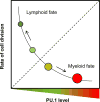Transcriptional Control of Dendritic Cell Development
- PMID: 26735697
- PMCID: PMC5135011
- DOI: 10.1146/annurev-immunol-032713-120204
Transcriptional Control of Dendritic Cell Development
Abstract
The dendritic cells (DCs) of the immune system function in innate and adaptive responses by directing activity of various effector cells rather than serving as effectors themselves. DCs and closely related myeloid lineages share expression of many surface receptors, presenting a challenge in distinguishing their unique in vivo functions. Recent work has taken advantage of unique transcriptional programs to identify and manipulate murine DCs in vivo. This work has assigned several nonredundant in vivo functions to distinct DC lineages, consisting of plasmacytoid DCs and several subsets of classical DCs that promote different immune effector modules in response to pathogens. In parallel, a correspondence between human and murine DC subsets has emerged, underlying structural similarities for the DC lineages between these species. Recent work has begun to unravel the transcriptional circuitry that controls the development and diversification of DCs from common progenitors in the bone marrow.
Keywords: common dendritic progenitor; dendritic cell; lineage commitment; transcription factors.
Conflict of interest statement
The authors have no conflicting financial interests.
Figures





References
-
- Mildner A, Jung S. Development and function of dendritic cell subsets. Immunity. 2014;40:642–56. - PubMed
Publication types
MeSH terms
Grants and funding
LinkOut - more resources
Full Text Sources
Other Literature Sources

